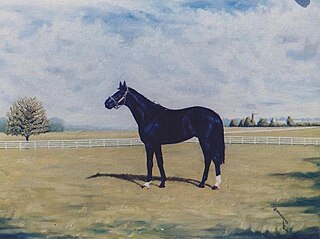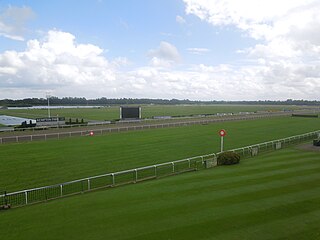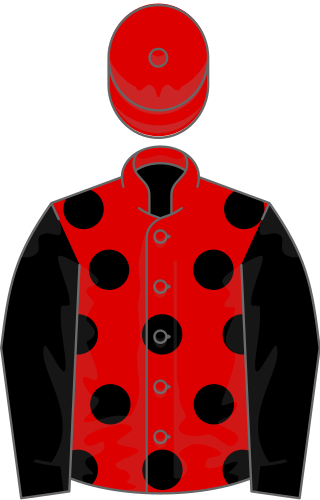
Horse racing is the second largest spectator sport in Great Britain, and one of the longest established, with a history dating back many centuries. According to a report by the British Horseracing Authority it generates £3.39 billion total direct and indirect expenditure in the British economy, of which £1.05 Billion is from core racing industry expenditure and the major horse racing events such as Royal Ascot and Cheltenham Festival are important dates in the British and international sporting and society calendar.

The Sussex Stakes is a Group 1 flat horse race in Great Britain open to horses aged three years or older. It is run at Goodwood over a distance of 1 mile, and it is scheduled to take place each year in late July or early August.

Ascot Racecourse is a dual-purpose British racecourse, located in Ascot, Berkshire, England, about 25 miles west of London. Ascot is used for thoroughbred horse racing, and it hosts 13 of Britain's 36 annual Flat Group 1 horse races and three Grade 1 Jumps races.
Leicester Racecourse is a horse racing course in Oadby, Leicestershire, about three miles south of the city centre.

Newmarket Racecourse is a British Thoroughbred horse racing venue in Newmarket, Suffolk, comprising two individual racecourses: the Rowley Mile and the July Course. Newmarket is often referred to as the headquarters of British horseracing and is home to the largest cluster of training yards in the country and many key horse racing organisations, including Tattersalls, the National Horseracing Museum and the National Stud. Newmarket hosts two of the country's five Classic Races – the 1,000 Guineas and 2,000 Guineas, and numerous other Group races. In total, it hosts 9 of British racing's 36 annual Group 1 races.

Kempton Park Racecourse is a horse racing track together with a licensed entertainment and conference venue in Sunbury-on-Thames, Surrey, England, near the border with Greater London; it is 16 miles south-west of Charing Cross in central London. The site has 210 acres of flat grassland surrounded by woodland with two lakes in its centre. Its entrance borders Kempton Park railway station which was created for racegoers on a branch line from London Waterloo, via Clapham Junction.

Doncaster Racecourse is a racecourse in Doncaster, South Yorkshire, England. It hosts two of Great Britain's 36 annual Group 1 flat races, the St Leger Stakes and the Racing Post Trophy.

Chester Racecourse, also known as the Roodee, is a racecourse located in Chester, England. The horse racing venue is officially recognised by Guinness World Records as the "oldest racecourse still in operation". Horse racing in Chester dates back to the early sixteenth century, with 1539 cited as the year racing began, although some sources give a date of 1512 for the first races in Chester. It is also thought to be the smallest racecourse of significance in England at 1 mile and 1 furlong (1.8 km) long.
Brighton Racecourse is an English horse racing venue located a mile to the northeast of the centre of Brighton, Sussex, owned by the Arena Racing Company.

Nottingham Racecourse is a thoroughbred horse racing venue located in Nottingham, Nottinghamshire, England. It is situated at Colwick Park, close to the River Trent and about 3 km east of the city centre.

Lincoln Racecourse is a former horse racing venue to the west of the city of Lincoln, at Carholme, a flat tract of common land, Lincolnshire, England. It was the original location of the Lincolnshire Handicap. The course closed in 1964, and the following year the race relocated to Doncaster Racecourse where a small change to the race title sees it run as the Lincoln Handicap.
Shadayid was an American-bred, British-trained Thoroughbred racehorse and broodmare. In a racing career which lasted from June 1990 to November 1991 she ran eleven times winning five races and being placed five times. Shadayid was one of the leading two-year-old fillies in Europe in 1990, winning all three of her races including the Group One Prix Marcel Boussac at the Longchamp. After winning the Fred Darling Stakes on her three-year-old debut, Shadayid took her unbeaten run to five by winning the Classic 1000 Guineas at Newmarket. Although she never won again, she finished second in the Coronation Stakes and the Sussex Stakes and third in the Haydock Sprint Cup and the Queen Elizabeth II Stakes. Shadayid was retired from racing to become a broodmare at the end of her three-year-old season after finishing seventh in the Breeders' Cup Mile.
Thatch (1970–1983) was an American-bred, Irish-trained Thoroughbred racehorse and sire. In a racing career which lasted from spring 1972 until July 1973 he ran nine times and won seven races. As a two-year-old he won three of his four races and was rated one of the best Irish juveniles of the season. In the following year he finished fourth on soft ground in the 2000 Guineas. In the summer he showed the form which led to him being rated the best European horse of his generation, winning the St. James's Palace Stakes, the July Cup and the Sussex Stakes. He was then retired to stud where he had some success as a sire of winners.

Elis was a British Thoroughbred racehorse and sire best known for winning the classic St Leger Stakes in 1836. In a racing career which lasted from July 1835 until April 1837 he won eleven of his fifteen races. He finished second in his four defeats, two of which came when he was matched against the undefeated Bay Middleton. As a two-year-old he won five of his six races including the Chesterfield Stakes, Molecomb Stakes, Clearwell Stakes and Criterion Stakes. In 1836 he rebounded from a defeat by Bay Middleton in the 2000 Guineas to win Drawing-room Stakes, Racing Stakes, and Lewes Stakes in the summer. Elis was one of the first horses to be transported by horsebox and landed a major betting coup for his owners by winning the St Leger. He had limited impact as a sire of winners before being exported to Germany.
Reel Buddy was an American-bred, British-trained Thoroughbred racehorse and sire best known for his upset win in the 2003 Sussex Stakes. He was foaled in Kentucky, and was sold to race in England after initially failing to attract interest from American buyers. In his first two seasons he won four relatively minor races from eighteen starts, showing himself to be a good and consistent racehorse but some way below top class. As a four-year-old in 2002 he showed improved form, winning the Abernant Stakes, Spring Trophy and Hungerford Stakes. In the following year he was beaten in his first five races before producing a career-best performance on his thirty-third start to win the Sussex Stakes at odds of 20/1. He was retired to stud at the end of the year and was later exported to Greece. He has made little impact as a breeding stallion.

Pether's Moon is an Irish-bred, British-trained Thoroughbred racehorse and sire best known for his win in the 2015 Coronation Cup. After showing some promise as a juvenile in 2012 he became a successful handicapper in the following year and ended his season with a win in the Listed Floodlit Stakes. As a four-year-old in 2014 he became a Group race performer, winning the Glorious Stakes and the Cumberland Lodge Stakes in England and the Bosphorus Cup in Turkey. In 2015 he was beaten in his first two races but then recorded his biggest win in the Group One Coronation Cup. He did not race again and was retired to become a breeding stallion.

Mrs Butterwick was a British Thoroughbred racehorse and broodmare. She spent most of her racing career competing in sprint races but recorded her biggest victory over a distance of one and a half miles when she won the Oaks Stakes in 1893. She showed good form as a two-year-old, winning three races and finishing second against older horses in the July Cup. In the following year she began her campaign with a defeat over five furlongs before being stepped up in distance for her upset win in the Oaks three days later. She spent the rest of her career competing in handicap races and won at least twice under big weights in 1894. After her retirement from racing she had considerable success as a dam of winners.
Ossian was a British Thoroughbred racehorse and sire. After finishing unplaced on his only start as a juvenile and running fifth on his thee-year-old debut, he made very good progress and ended the year as the biggest money-winner in Britain. He demonstrated consistent top-class form to win the Sussex Stakes, Drawing Room Stakes, Great Yorkshire Handicap, St Leger Stakes and Great Foal Stakes a well as being placed in the Craven Stakes, Prince of Wales's Stakes, Ascot Derby and Champion Stakes. As four-year-old he developed respiratory problems but walked over for the Claret Stakes and was placed in both the Goodwood Cup and the Doncaster Cup. He made little impact in his short career as a breeding stallion before dying at age 11 while being exported to the United States.

Stradivarius is an Irish Thoroughbred racehorse. After winning one minor race as a two-year-old, he emerged as a top-class stayer in the following year, winning the Queen's Vase and Goodwood Cup as well as finishing a close third in the St Leger. As a four-year-old he won the Yorkshire Cup, Ascot Gold Cup, a second Goodwood Cup and the Lonsdale Cup, securing a £1 million bonus for winning all four races, and ended the year by winning the British Champions Long Distance Cup. In 2019 he repeated his victories in the Yorkshire Cup, Ascot Gold Cup and Lonsdale Cup, and won a third Goodwood Cup, giving him a second £1 million bonus. With jockey Frankie Dettori on board, on 18 June 2020, Stradivarius won his third Ascot Gold Cup and on 28 July 2020, he won his record fourth Goodwood Cup. In 2021 he won the Lonsdale Cup for the third time and in 2022 he achieved a third victory in the Yorkshire Cup. He was retired to stud at the end of the 2022 season, having won a record 18 European Group races.
Lightning Spear, is a British Thoroughbred racehorse and sire. He was lightly campaigned in his early career but eventually developed into a top class miler who won the Celebration Mile in 2016 and 2017 and recorded his biggest victory at the age of seven when he took the Sussex Stakes. He was also placed in numerous top-class races including the Queen Anne Stakes, Queen Elizabeth II Stakes and Lockinge Stakes. Lightning Spear was retired from racing to become a breeding stallion.
















